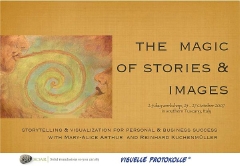 Reinhard Kuchenmuller and his wife, Dr. Marianne Stifel, work for corporate clients doing visual facilitation. In an interview on Projects@Work (may require log-in), Kuchenmiller states:
Reinhard Kuchenmuller and his wife, Dr. Marianne Stifel, work for corporate clients doing visual facilitation. In an interview on Projects@Work (may require log-in), Kuchenmiller states:
Information presented in visual language as a picture-word combination is understood better and more quickly than information that is solely text-based. This is because information that is established in the non-verbal sphere of intelligence arouses associations and thus, remains better anchored for a longer period. We make use of visual learning preferences to achieve this goal. … It’s a simplification to say [that pictures work better than words alone in conveying information and making it stick in the mind], but we know that there are two sides of the brain, the creative and the logical. We’re all used to using the logic part at work, and saving the other part for our private lives, our hobbies, the cinema. I think the creative brain brings more deep insight to serious questions and it is connected to a universal treasure of pictures. After all, mankind started to draw pictures 40,000 years ago, and we only developed writing about 5,000 years ago. So, for 35,000 years, drawing was enough.
I recently did some research on learning styles for a book my partner and I are working on about study skills. I would venture to say the effectiveness of pictures over words or vice versa may depend largely on the type of learner you are – visual, auditory, etc. The debate reminds me a bit of the PowerPoint vs. story debate. Pecha Kucha, the Japanese-inspired minimailist slide-show style, leans toward the picture side, but requires spoken words to fully tell its story.
